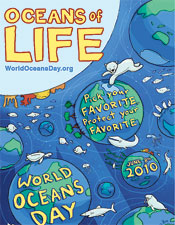It was a Sunday evening. Their parents had taken Puncha and Panchie to the beach. They were
enjoying building a sand
castle on the beach, when Panchie spotted a strange hole in the sand.
"Aiya.. Aiya.. Have you seen that hole..? Look!" Panchie shouted to her busy brother. She had also
spotted some movements and started running toward it.
"There is also something in it Aiya," Panchie yelled to hasten her brother.
Even though there was nobody to see, the stranger had left some tiny footprints all over the sand. After a careful search, Puncha
managed to spot the stranger who made the
footprints.
It was a tiny crab that was very similar to the colour of the sand. Puncha was curious, so he had a
closer look. "Hey Panchie – the crab has ten feet," he
whispered.
Puzzled by what the kids were looking at, father too came up to them. "Yes, all the crabs are called decapods because they have 10 feet. The first two have
developed as claws and are called Cheliped," explained father. "Crabs are also
invertebrates that do not have a backbone, but have a protective shield around
the body called the
exo-skeleton".
"Look… there is a different crab," Puncha pointed at another odd looking crab that had retracted the body into its shell. Father picked it up in his hand. "This is a Hermit crab, Puncha", father identified the little fellow still hiding in the shell.
"Hermit crabs do not have a hard shell. So it finds an empty sea shell and
transforms it into a mobile home carrying it on its back.
When they feel in danger, Hermit crabs retract its whole body into the shell", father explained the
mysterious behaviour of the Hermit. "When grown, the Hermit crab discards its old shell and finds a new home – another spacious sea shell!"
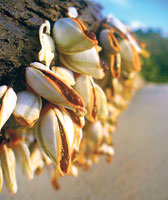 |
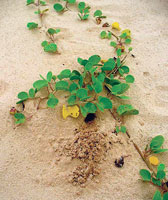 |
| Goose Barnacles |
Goat's Foot (Bim Thamburu) |
Mussels on a log
Fascinated by the crabs found on the coast, the
family kept on walking along the beach.
They came across a large log that had washed ashore last night. It was
covered by Mussels attached tightly. There were
hundreds of them. "Are they still alive Thaththa..?" Panchie
questioned.
"Yes, they are still alive. Can you see the fleshy body part of this mollusc that lives in the sea..?" father asked, pointing to the mouth of the shells. These are also called Bivalves because they have a shell consisting of two
asymmetrically rounded halves called valves.
They are mirror images of each other, joined at one edge by a flexible ligament called the hinge", father said.
With the help of Puncha and Panchie, father threw the log back into the sea, so that the mussels too could enjoy the sea.
Grass in the sand
They had also observed a vine like grass that spread around the sandy beach. Before questions came from the kids, father volunteered to explain what it was. "These are called Goat's Foot or 'Bim Thamburu'. Look at the shape of the leaves – it really looks
similar to a Goat's Foot," father explained to the kids.
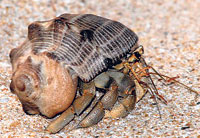 |
| Hermit crab |
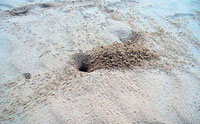 |
| A crab hole and footprints. |
"Unlike other plants, these can grow under the effects of salt water. Goat's Foot plants also help to keep the sand on the beach tight, so that other plants can start growing. Without these, it will take a longer time for vegetation to come out in the beaches", father explained the importance of the plant.
The walk on the beach made both the kids thirsty, so they were thrilled to see an ice cream seller who came to the beach. Already there were a few kids, enjoying
ice cream – but they had already thrown the
polythene wrappers of the ice cream onto the beach.
"That's bad," commented father. "This polythene will be washed into the sea and it will not be good for the health of the oceans. Sometimes these might be eaten by the creatures of the oceans and they will also get sick. So never pollute the beaches or throw anything bad into the ocean," father advised the kids.
Both Puncha and Panchie kept their wrappers safely, until they found a garbage bin to dump them.
The crab, mussels and Goat's Foot plants are all parts of the coastal
ecosystem, but there are more creatures that live in the oceans... Stay in touch with your friends – Puncha and Panchie for more news about them… |

